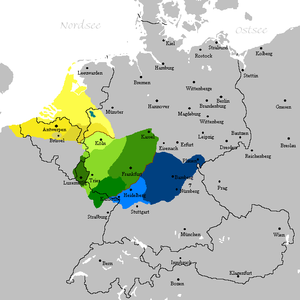Central Franconian languages
--- The issue of Central Franconian languages is of utmost importance today. With the advancement of technology and changes in society, it is crucial to understand the implications and opportunities this topic presents. In this article, we will explore different aspects related to Central Franconian languages, from its impact on daily life to its influence on the economy and politics. In addition, we will analyze different perspectives and opinions on the matter, in order to provide a comprehensive and objective vision about Central Franconian languages. Read on to discover everything you need to know about this fascinating topic!
This article has multiple issues. Please help improve it or discuss these issues on the talk page. (Learn how and when to remove these template messages)
|
| Central Franconian | |
|---|---|
| Middle Franconian (Mittelfränkisch) | |
| Geographic distribution | North Rhine-Westphalia, Rhineland-Palatinate, Saarland, Lorraine, Luxembourg, Liège, Limburg |
| Linguistic classification | Indo-European
|
| Glottolog | midd1319 |
 Central Franconian among the Franconian languages.
Ripuarian
Moselle Franconian
Luxembourgish | |
Central or Middle Franconian (German: mittelfränkische Dialekte, mittelfränkische Mundarten, mittelfränkische Mundart, Mittelfränkisch) refers to the following continuum of West Central German dialects:
- Ripuarian (spoken in the German state of North Rhine-Westphalia, in eastern Belgium, and the southeastern tip of Dutch Limburg)
- Moselle Franconian (in German Rhineland-Palatinate and Saarland, in eastern Belgium and French Lorraine)
- Luxembourgish (in Luxembourg and the adjacent areas of Belgium and France)
Luxembourgish is often included within Moselle Franconian, but sometimes regarded as a separate group. The German-speaking Community of Belgium comprises both Ripuarian and Moselle Franconian dialects. The Central Franconian dialects are part of a continuum stretching from the Low Franconian language area in the northwest to the Rhine Franconian dialects in the southeast. Along with Limburgish, Central Franconian has a simple tone system called pitch accent.
The Central Franconian language area is not to be confused with the Bavarian administrative district of Middle Franconia, where East Franconian dialects are spoken.
The Central Franconian dialects are of particular interest to linguists because of the tonal distinctions made between different words, for example (Ripuarian) zɛɪ (tonal accent 1) "sieve" vs. zɛɪ (tonal accent 2) "she". See Pitch-accent language.
References
- ^ Russ, Charles (2013). The Dialects of Modern German: A Linguistic Survey. Routledge. p. 136. ISBN 978-1-136-08668-7. Retrieved 17 Feb 2018.
- ^ de Vaan, M. "Towards an Explanation of the Franconian Tone Accents", (Leiden University Repository), p. 2.